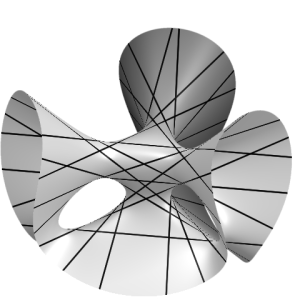Oxford Mathematician Thomas Prince talks about his work on the construction of Fano manifolds in dimension four and their connection with Calabi-Yau geometry.
"Classical algebraic geometry studies the vanishing loci of finite collections of polynomial equations; usually under some conditions that ensure this locus has some desirable properties. The first objects studied in this subject (in its modern history) were Riemann surfaces, one dimensional objects over the complex numbers, topologically equivalent to $n$-holed tori. The attempt to replicate the classification of curves in the context of algebraic surfaces made by the 'Italian school' led by Castelnuovo and Enriques in the early 20th century led to a fundamental insight: the classification divides naturally into two distinct problems. First one studies a courser 'birational' classification of surfaces, before analysing the surfaces within each birational class. In two dimensions the second problem has a simple solution: these surfaces are related by 'blowing up' and 'blowing down', explicit operations first described by Noether. This became the model and prototype for the modern subject of birational geometry, which developed rapidly in the later 20th century, with fundamental contributions made by Hironaka, Mori, Shafarevich, and others.
In the contemporary treatment of the subject, a particularly privileged role is given to two classes of algebraic (or complex analytic) objects. The Calabi-Yau manifolds, generalising elliptic curves; as well as a particular 'minimal' class of surfaces called K$3$ surfaces, and Fano manifolds. Fano manifolds play a key role in Mori's minimal model program, itself a sweeping higher-dimensional generalisation of key methods used in the classification of surfaces. In particular this program led to the spectacular Mori-Mukai classification of Fano manifolds in dimension three, building on work on Iskovskikh.
The construction of Fano manifolds in dimension four is thus a central open problem, and the focus of ongoing research. My own interest relates to their connection with Calabi-Yau geometry: a very rough analogy would say that a Fano manifold is to a Calabi-Yau manifold what a manifold with boundary is to a manifold. Recent ideas from string theory - in particular from the field of mirror symmetry - have introduced a number of new tools to the study of Calabi-Yau manifolds, particularly following Kontsevich, Strominger-Yau-Zaslow, and Gross-Siebert. Following Givental and Kontsevich the subject of mirror symmetry has also been extended to incorporate Fano manifolds, and suggests an approach to their construction via toric degeneration. The focus of my own research is to develop these insights to produce systematic constructions of Fano manifolds along quite a different line from that taken in birational geometry. Recent progress includes a new construction of surfaces with certain classes of singularities and the classification of 527 'new' Fano fourfolds - obtained in joint work with Coates and Kasprzyk - as complete intersections in 8-dimensional toric manifolds."


